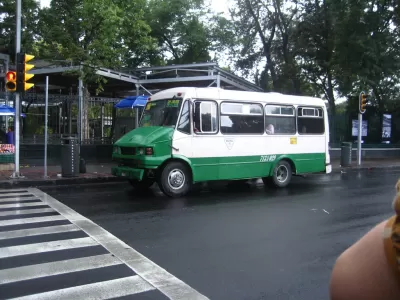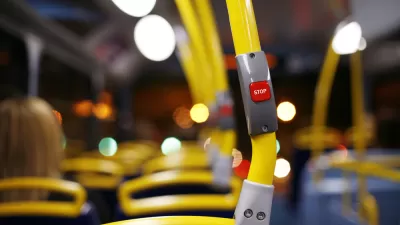Halfway between public transit and private cars, new and varying forms of 'microtransit' threaten to out-compete traditional public services. Concerns about equity, inclusion, and employee compensation follow.

In this piece, Jarrett Walker identifies a potential niche for microtransit, which includes services like UberPool, LyftLine, Bridj, and Leap, among others. What we should avoid, he argues, is a situation where private microtransit companies completely replace public transit.
Instead, "The way forward is for less expensive service tools, including the upstarts, to focus on lower-density suburbia where the land use patterns make efficient big-vehicle transit geometrically impossible. The upstarts could even become contractors of the transit agency part of the time -- paid to do things that they can do more efficiently than big buses can -- as taxis often are today."
If private and public transit cannot find equilibrium, we may face either a cutthroat mobility market or more of the same inefficient public services. "But when I hear the upstarts appealing to elitism, and derogating conventional high-efficiency transit, I wonder where we'll end up ... One thing is for sure: This sector is going to need strong regulation to turn it into a force for good."
Of course, private microtransit has long been a viable mode for city-dwellers in poorer countries. Lacking all start-up flashiness, a multitude of vans and small buses already fills the gaps left by public transit in places like Mexico City and Mumbai.
FULL STORY: Microtransit: good or bad for cities?

Alabama: Trump Terminates Settlements for Black Communities Harmed By Raw Sewage
Trump deemed the landmark civil rights agreement “illegal DEI and environmental justice policy.”

Study: Maui’s Plan to Convert Vacation Rentals to Long-Term Housing Could Cause Nearly $1 Billion Economic Loss
The plan would reduce visitor accommodation by 25% resulting in 1,900 jobs lost.

Why Should We Subsidize Public Transportation?
Many public transit agencies face financial stress due to rising costs, declining fare revenue, and declining subsidies. Transit advocates must provide a strong business case for increasing public transit funding.

Paris Bike Boom Leads to Steep Drop in Air Pollution
The French city’s air quality has improved dramatically in the past 20 years, coinciding with a growth in cycling.

Why Housing Costs More to Build in California Than in Texas
Hard costs like labor and materials combined with ‘soft’ costs such as permitting make building in the San Francisco Bay Area almost three times as costly as in Texas cities.

San Diego County Sees a Rise in Urban Coyotes
San Diego County experiences a rise in urban coyotes, as sightings become prevalent throughout its urban neighbourhoods and surrounding areas.
Urban Design for Planners 1: Software Tools
This six-course series explores essential urban design concepts using open source software and equips planners with the tools they need to participate fully in the urban design process.
Planning for Universal Design
Learn the tools for implementing Universal Design in planning regulations.
Smith Gee Studio
Alamo Area Metropolitan Planning Organization
City of Santa Clarita
Institute for Housing and Urban Development Studies (IHS)
City of Grandview
Harvard GSD Executive Education
Toledo-Lucas County Plan Commissions
Salt Lake City
NYU Wagner Graduate School of Public Service





























